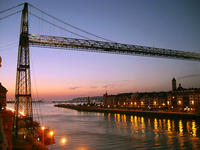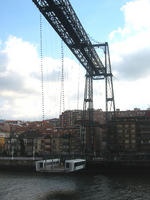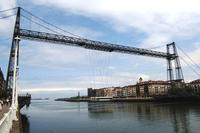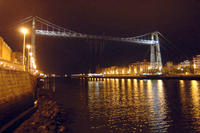You are in: Europe -> Spain -> Vizcaya Bridge, and traditional search or Image Gallery will yield results of this site only
Vizcaya Bridge
| Site number: | 1217 |
|
| Type of site: | Cultural | |
| Date: | 1893 | |
| Date of Inscription: | 2006 | |
| Location: | Europe, Spain, Basque Country, Province of Bizjaia | |
Up to 75 images are shown here. Click on each for more details or on Image Gallery for more images.
| Description: | The Vizcaya Bridge, designed by the Basque architect, Alberto de Palacio in 1893, sits at the mouth of the Ibaizabal estuary west of Bilbao. Spanning 160 m the bridge is 45-metre-high; it fuses iron–working traditions of the 19th-century with the then innovative lightweight technology of twisted steel ropes. As the world’s first bridge to carry people and traffic on a high suspended gondola it served as a model for many similar European, African and the American bridges - few of which survive. With its original use of lightweight, twisted steel cables, it is renowned as an outstanding architectural iron construction of the Industrial Revolution. --WHMNet paraphrase from the description at WHC Site, where additional information is available. | |
| The Vizcaya Bridge (Bizkaiko Zubia in Basque, Puente de Vizcaya in Spanish), is a transporter bridge that links the towns of Portugalete and Las Arenas (part of Getxo) in the Biscay province of Spain, crossing the mouth of the Nervion River. For the locals it's commonly named Puente Colgante that is Spanish for Suspension Bridge. That constitutes a misnomer, because it is really a transporter bridge, being a different structure from a suspension bridge. However, the common name is widely used in the area and even in the official website. It is the world's oldest transporter bridge and was built in 1893, designed by Alberto Palacio, one of Gustave Eiffel's disciples. It was the solution given by the engineer to the problem of connecting the two towns without disrupting the maritime traffic of the Port of Bilbao and without having to build a massive structure with long ramps. The service was only interrupted four years during the Spanish Civil War, when the upper section was dynamited. From his house in Portugalete, Alberto Palacio could see how his master work was partially destroyed just before his own death. On July 13th of 2006 it was declared a World Heritage Site by UNESCO. --Wikipedia. Text is available under the Creative Commons Attribution-ShareAlike License. | ||
| Source: | http://whc.unesco.org/en/list/1217 | |
| Reference: | 1. UNESCO World Heritage Center, Site Page. | |
















